It’s the question everyone keeps asking us: “Why in the world did you guys, two totally inexperienced cyclers, even want to bike the length of Vietnam?” It’s a valid question, and like most of the big challenges we throw ourselves into, the answer is perfectly straightforward. We decided to cycle Vietnam because it sounded like fun. That’s ultimately it. Our only prior cycling experience was a three-day jaunt down Taiwan’s East Coast, and obviously that was child’s play in comparison to six weeks of adventuring through Vietnam.
But we did it. We opened ourselves up to new possibilities and embraced the challenge—both physically and mentally—and somehow, beyond any reasonable expectations, we succeeded.
We cycled over 1,000 miles from Hanoi to Ho Chi Minh City, and though it proved to be one of the most challenging endeavors of our lives, we wouldn’t have wanted to experience Vietnam any other way.
If we can cross-country cycle Vietnam, then you can too.
It takes a bit of physical strength and a whole lot of determination, but that’s about it. Of course, you might need some bikes and accessories and want to know where to go and how to do it. Don’t worry—we’ve got you covered below. And really, those are all just added bonuses anyway.
If you’re interested in seeing the world from the biker’s lane, then this is the guide for you. It’s designed specifically for cycling Vietnam, but a lot of the tips are applicable for cycle touring anywhere! Good luck and happy pedaling!
Before you go: Travelers from the U.S., don’t forget that you need a Vietnam visa for U.S. Citizens. There are a few different ways to go about getting one; the article we’ve linked to here explains the details.
Table Of Contents
Buying a Bike To Cycle Vietnam
Cross-Country Cycling Essentials
Planning Your Vietnam Cycling Route
Buying a Bike To Cycle Vietnam
In Vietnam, almost everyone has a bike. Children bike to and from school in herds of 20 or more while old women use their bikes to balance heaps of market goods. Because of Vietnam’s biking culture, it’s easy to find bicycles for sale in major cities and rural villages alike.
Of course, not all these bikes are geared towards long-distance cycling and that’s where a bit of bike buying knowledge comes in handy. We bought our bicycles from one of the many bike shops lining Ba Trieu Street in Hanoi. They were new and held up fairly well during the tour. The bikes on this street are cheaper, and therefore require a bit of cleverness to get a good deal. Another option is to visit the Hanoi Bicycle Collective. This shop is owned by a super knowledgeable biking expat who sells mostly high-end Japanese bikes. You’ll pay much more but be awarded with confidence in your purchase.
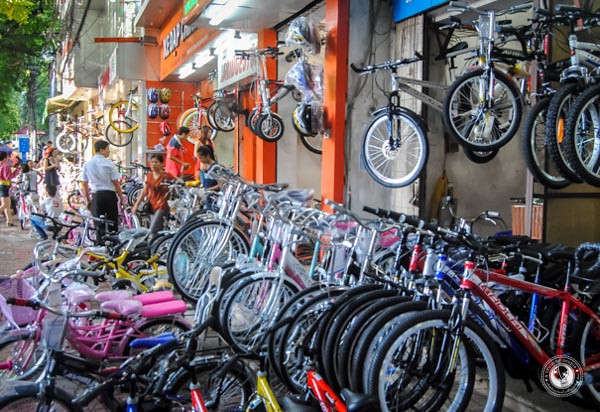
Our budgets were pretty tight, so cheap bike street it was. Like I already noted, we only had minor problems with our bikes, all of which were easily fixed in a few minutes (flat tires, loose brakes, etc). We paid a total of $500 for two bikes and all accessories. That was less than the price of one bike from the collective, so we were quite satisfied. Remember, wherever you purchase your bike, bargain on the price!
Bike Buying Tips:
1. Vietnam’s roads are just horrible. You’ll want a hybrid between a road bike and mountain bike if you are going to stand a chance against the potholes and mud. We were very grateful for our front suspension and thick tires.
2. Test the gears. Make sure they go all the way up and all the way back down again without any problems. And yes. A bike without gears is out of the question unless you have thighs of steel.
3. Pinch the tire spokes to make certain they are tight. While you’re down there, check the tread on the tires to be sure they aren’t old tires on a new bike.
4. A bike with adjustable seat, disk breaks, and forward facing handlebar attachments will make the trip more enjoyable.
5. Buy your bike a few days before your trip begins! Ride it around the city, get a good feel for it, and make sure no problems develop. If you notice something iffy, don’t be shy to return it to the store for complementary fix-ups.
Cross-Country Cycling Essentials
There were a few cycling accessories we absolutely loved, a handful of things we didn’t use at all, and of course a sprinkling of items we wish we would have had. Here’s what we would take along next time:
- To store all your things. Be sure to grab some extra bungee cords to wrap up whatever you’re carrying on the rack.
- For cycling within the towns and cities at night.
3. Bike Locks
- You don’t want to get halfway only to wake up stranded and bike-less.
4. Attachable Viking Horn
- All the vehicles honk incessantly. It would have been really nice to make some noise back at them.
5. Helmet
- Once you see the traffic, you’ll understand why.
- The spandex might not be sexy but the cushioning is crucial.
7. Grip Tape and Gloves
- Sweaty hands slipping off the front are just not fun.
8. Sunscreen
- We had huge difficulty finding sunscreen when we ran out of our supply. Bring extra with you—Vietnamese don’t use it.
9. Allen Wrenches and Spare Tire Kit
- For making small adjustments and just in case.
10. Smart Phone
Vietnam has a very extensive 3G network; we relied heavily on our iPad, phones and Google Maps during our self-guided cycling tour. I’m not sure we would have ever found our way out of Hanoi without it!
Other than what’s listed above, don’t pack much. I definitely overdid it (and our shopping spree in Hoi An didn’t help). Think bare essentials: two cycling shirts, lightweight athletic shoes, one pair of flip-flops, two pairs of clothes to change into post-cycling, and a first-aid kit. Toiletries and towels come in most guesthouses or can be purchased in individual packets everywhere in Vietnam.
Planning Your Vietnam Cycling Route
There are essentially three options for getting from Hanoi to Ho Chi Minh City:
-
-
-
- Take Highway One
- Take the Ho Chi Minh Highway
- Do a combination of them both
We went with the latter option, primarily because it encompassed everything we wanted to see. Highway One is the easiest option. It’s straightforward, the road conditions are better, and there is a large shoulder for cyclists. The traffic is heaviest on Highway One, but we found it to be safer than other areas of Vietnam. Hotels and restaurants are standard along Highway One because of all the traffic it sees. The highway isn’t nearly as beautiful as its inland counterpart, and you won’t hear as many ‘hallos’ from the locals. Still, it’s quick and cuts through many of the main tourist cities like Danang, Hue, Hoi An, and Nha Trang.
The Ho Chi Minh Highway is stunning. Nearly all the photos that we posted in our Tour de Vietnam segment were from this route. Expect poor road conditions, crazy traffic, and mountains to traverse. There are still plenty of towns along the way, but you’ll have to time your itinerary to strategically arrive at them when you’re ready for a hotel or meal. Not too many foreigners cut through the rural areas around the HCMH—even less do it on a bicycle. You’ll receive lots of smiles, cheering, questioning looks, and excitement from the locals you pass.
Though the Ho Chi Minh Highway was much more difficult, it was also the highlight of our journey. That said, we also wanted to experience a bit of Dong Hoi, Hue, and Hoi An on Highway 1. So our Vietnam cross-country cycling route included a little bit of everything!
Here is a closer look at the cycling route we took across Vietnam:
We also found this blogger’s itinerary to be extremely helpful. He details the road conditions for each day and has lots of pictures. However, he’s a cycling beast, and we almost always fell short on the few days we tried to match him.
Should you find yourself stuck or unable to cycle farther, trains run down the east coast, buses and vans frequent the entire country, and all transportation will allow you to put your bike on board. It is possible to flag down a bus on the side of the road but know that the driver will charge you an absurd amount of money. It’s easier to get a more standard deal at a bus or train station.
Finding Food and Accommodation While Cycling Vietnam
If a place appeared to have at least a handful of streets on Google Maps, it almost always had a few hotels and restaurants. There was only one time we found ourselves worried about where we would lay our heads, but luckily we had our guardian angels and a kind Vietnamese family to save the day. There’s no need to carry a tent, and we’re not sure how safe we would have felt sleeping on the side of the road anyway. Our cheapest accommodation was $6 a night, while our most expensive was an Oceanside splurge at a four-star hotel for $45.
Highway One was a bit more expensive (averaging around $12 a night) while the South was nearly always under $10.
*Tip: Nha Nhgi means guesthouse. Often they are less expensive than places that say ‘hotel’ in English but still offer the same amenities. Restaurants and cafes are frequent, provided you don’t mind small, open-air establishments serving just one daily dish. Again, utilize that GPS and plan ahead (especially on some portions of the HCMH), but don’t worry too extensively. The necessities are easy to come by.
Vietnamese cuisine is amazing, so don’t worry about finding enough calories to burn on your cycling adventure! In this post we share 17 of our favorite Vietnamese dishes to keep an eye out for.
Dealing With Emergencies While Cycling Vietnam
Luckily we didn’t have to deal with any emergencies ourselves. Should you need assistance, call 113 for police or 115 for an ambulance. If your only crisis is with your bike, look for a small ‘Honda’ shop. These are motorbike repair stores, but the owners are often very handy with a bike too. They won’t charge for service, only the parts themselves. We frequently would get our tires pumped up, our gears oiled, and our brakes tightened for next to nothing.
Is it safe to cycle Vietnam on your own?
Overall we felt very safe in Vietnam. But like anywhere in the world, there were a few instances when we felt uncomfortable. We followed our instincts. If ever we were a little unsure of someone who had stopped to talk to us or was looking a little too closely at our belongings, we said a friendly goodbye and cycled away. Luckily that was the extent of it. Don’t pull out expensive technology on the side of the road; it’s all too easy for someone to grab it and drive off. We also had a wallet picked out of one of our saddlebags while it was with hotel security. Being on a bicycle does make you a bit more vulnerable for the same reasons it allows you to interact more with locals. Just play it smart as you would anywhere.
Other Ways To Cross-Country Cycle Vietnam
If you want to cycle but aren’t too keen on tackling it alone, there are numerous cycling companies that will take you on a guided bike tour of Vietnam. Often a lot of your journey will be cushioned with bus and van rides, but that isn’t necessarily a bad thing. There’s also a support van that follows along and carries your belongings. We met a couple that had completed a one-week cycling tour and only had good things to say about it.
For those who have asked, our total trip for two people over six weeks (including bikes and some shopping) cost us $3000 USD. You might spend the same amount on a one-week tour with a company.
Cycling Vietnam was certainly one of our most adventurous and memorable travel experiences to date. Thanks for being with us on the journey—we hope we have inspired you to try something new and have your own adventure, whatever that may be!
Do you have any more questions about Cycling Vietnam? Drop them in the comments below!
-
-

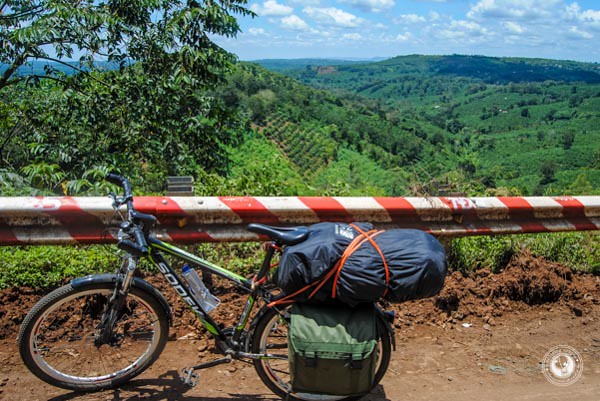
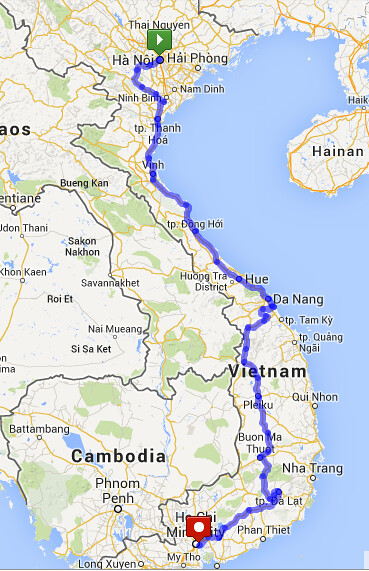

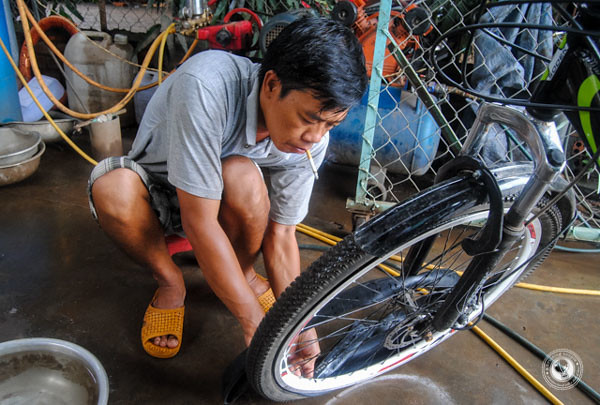
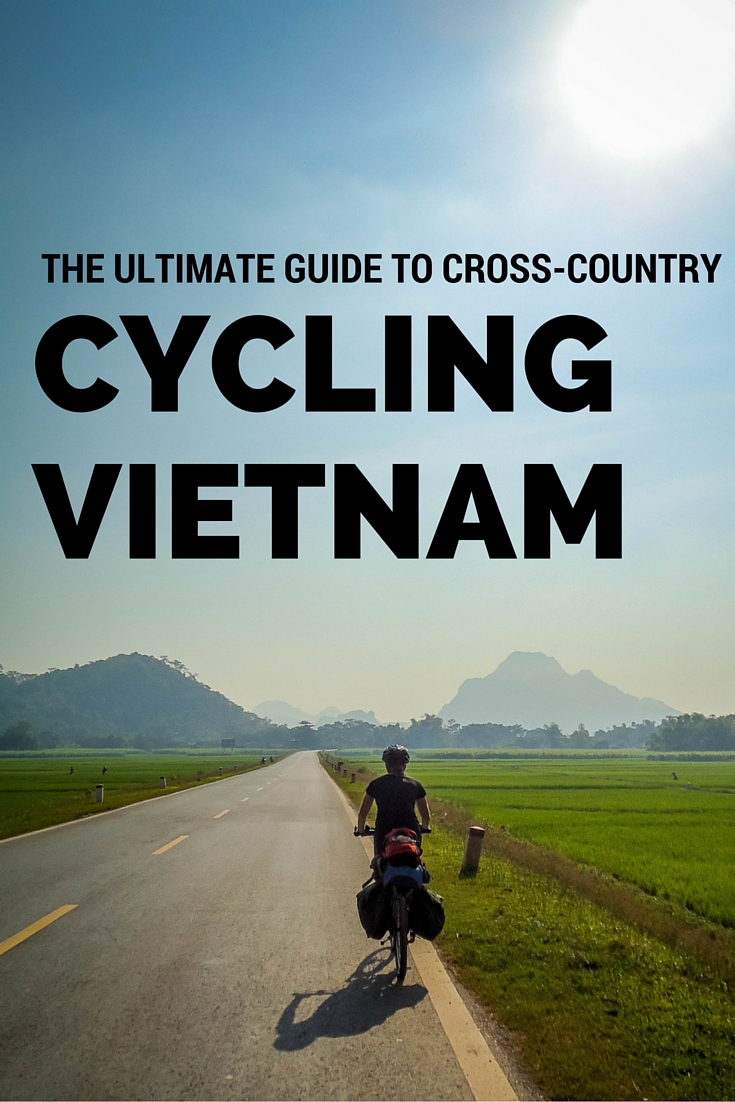
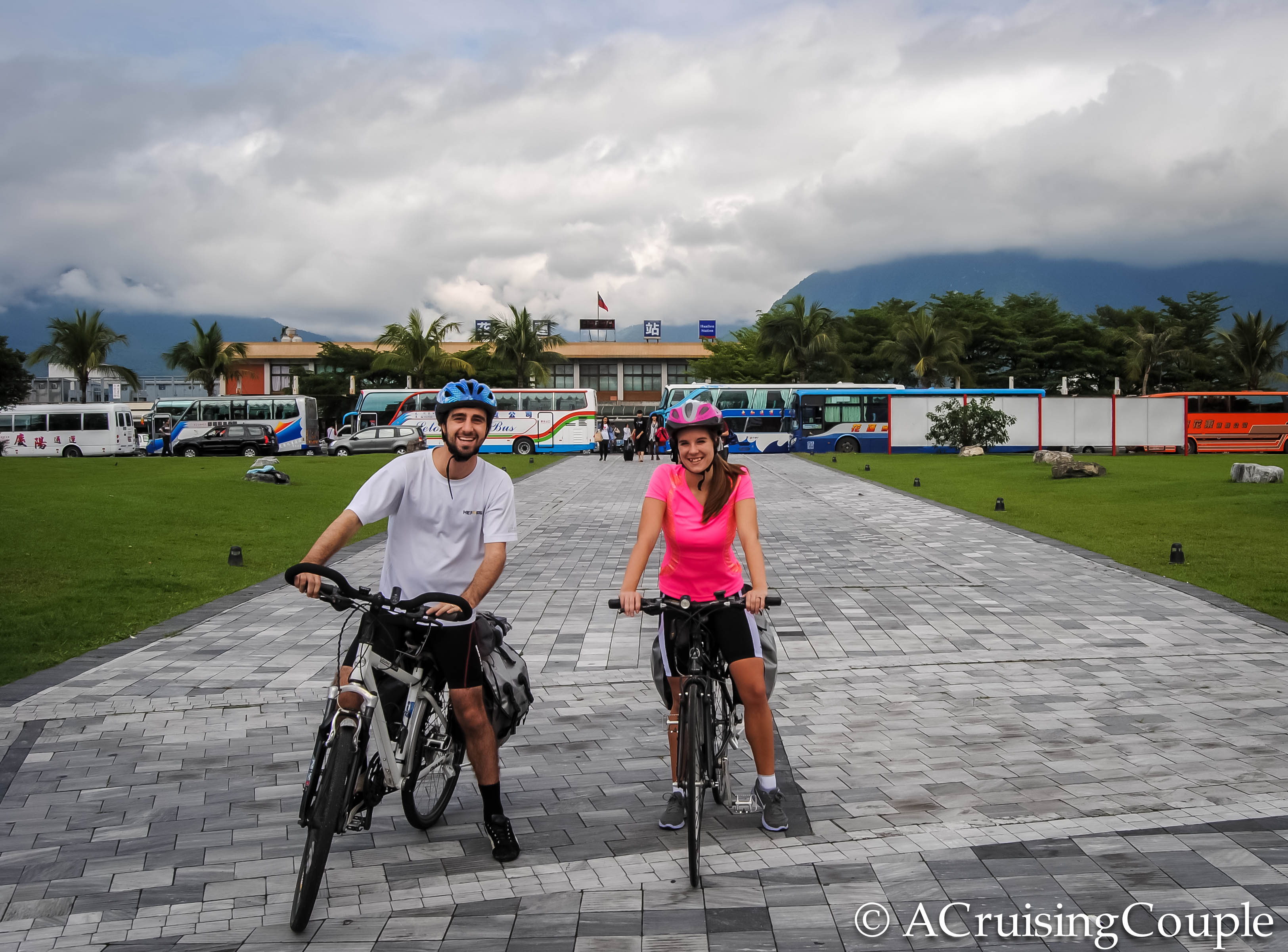
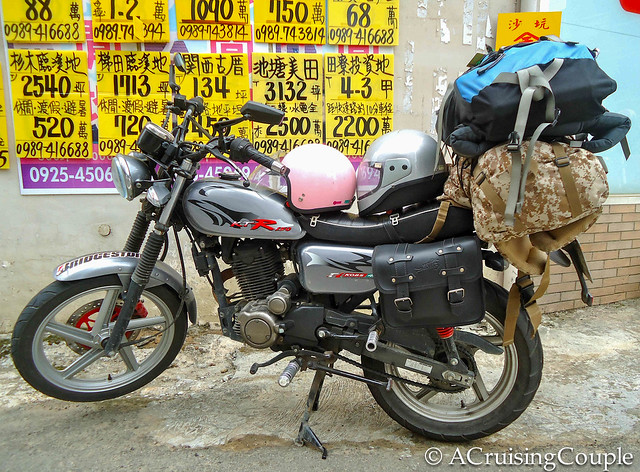
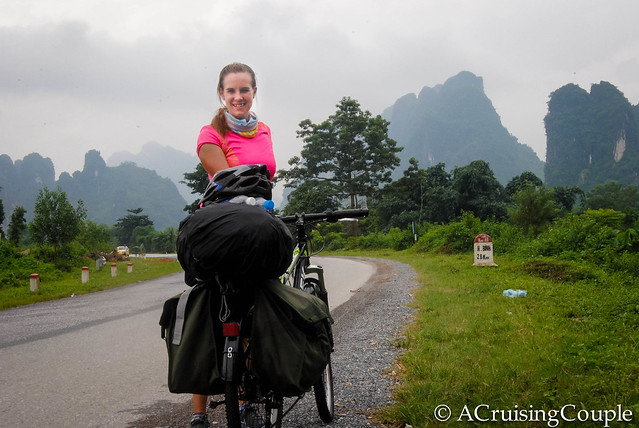
This sounds amazing…I’m no biking expert but doing something like this is right up my alley. Thanks for all the info and tips! :)
Ashley Hubbard recently posted…Top Destinations to Spend Halloween
I hope you get the chance to give it a try!
Cycling is a brilliant way to travel – moving at a slower pace through different terrains, you can engage more deeply with your destination.
Love love love this post! What did you do with your bikes after the trip? :)
Jamie recently posted…Barcelona–Gaudi’s Quirky Canvas
Luck would have it we were actually able to sell them in HCMC.
we have set up the Ho Chi Minh Trail Challenge. We aim to do it in 2015. I liked your information. Thanks, very helpful.
our web is http://www.thehochiminhtrailchallenge.com
We are fundraising for the British Heart Foundation.
What a great cause! I can’t wait to follow you on your journey!!! If you have any more questions about cycling in Vietnam we’d love to help anyway we can :-) Best of luck!
Another exciting, wonderful blog! I love following your trips, vicariously travelling with you. Love you both. It was wonderful to see you in person recently!!
Thanks! It was great to see you too! Hope all is well and you’re taking it easy :-)
I think the big question is: would you do it again? Either in Vietnam or another country? ;)
We really enjoyed our time motorbiking through VN, but I think we both learned a lot on that trip and felt that on a second go around, we would do some things much differently. Honestly, we found the road conditions so bad at times and in comparison to the north, we felt like most of the scenery we encountered even on the HCMC one we got past Hue just didn’t really compare. I think it’s one of those things that I am glad to have done once, but wouldn’t necessarily do again! You are right that being out on the road by yourselves is the best way to get to see the real Vietnam and its people.
Steph (@ 20 Years Hence) recently posted…Our 2013 Capture the Colour Entries
That is a big question :-p We wouldn’t change a single thing about our trip (only that we would have wanted more time) but our bums will need some time to recover before we do another cycling journey like this one :-)
Fantastic post! We recently met a Couchsurfer who was cycling across Japan, and it seemed like an amazing experience. I love cycling, but I always felt like I wouldn’t have the skills/knowledge to pull off a long journey. It’s really inspiring that you guys managed to do it!
Jessica recently posted…A Tale of Two Towns: Magome and Tsumago
Our biking skills/knowledge shouldn’t have gotten us out of Hanoi but somehow we managed to make it :-p We surely qualified as inexperienced cyclers before the trip but everyone was so helpful along the way we never would have made it without help from the locals.
I still think what you two did is simply amazing! It’s ‘easy’ for an expert to take a bike and start a similar trip you did. For somebody that like you and me too aren’t so used to cycling is a real challenge. Great tips here! :)
Franca recently posted…How We Tried To Love Vientiane, But Failed
I really don’t think we knew what we were getting ourselves into at the time. Glad we could share some of what we learned along the way :-)
This is a really useful guide, guys. You’re making me really consider doing something like this…just have to convince my partner that it’s a good idea!
Sam recently posted…Burmese Street Food: 10 Tasty Meals for Under 1 Dollar
Go for it! It is an adventure we will never forget :-)
Hi guys, loved this, we’ll be in Vietnam soon but we’re more likely to take the train down the coast. I really miss my bike and would love to do more things like this but we’d have to shorten the distance and lower the costs for it to be feasible.
Andrew recently posted…Batad: The Toughest Trek
I hope you enjoy your trip! Vietnam has some beautiful beaches and the train through the Hai Van Pass is legendary.
Great! Cycling is the best way to explore a place. Thanks for the guidance!
Renuka recently posted…7 Best Trails In The Northern Hills Of India
Cycling offered us a surprising amount of freedom and ability to make ourselves available to meeting locals. They love their bikes in Vietnam.
Sounds like an awesome adventure you two! What a long journey!
Thanks Kelly! It was a lot of fun :-)
Congrats on finishing the Vietnam trip. I really admire your guts and determination!
Thanks Karel!
We just arrived in Vietnam yesterday!
We won’t be cycling around but I’ll be gathering a lot of ideas from your blog – so thanks in advance! ;)
Zara @ Backpack ME recently posted…Public Toilet TIPS!
That’s exciting! What spots do you have in mind so far?
Wow! Great stuff, guys! I’m thinking about going on another cycling adventure myself. I just bookmarked it ;-)
Bram recently posted…Irish Heritage – A Photo Essay
Thanks Bram :-) I hope you get the chance to use it while cycling Vietnam.
Nice post.Viet Nam is very beautyful.Im living in VietNam but i dont have a opportunity to travel from Ha Noi to Ho Chi Minh City like you.Note : ‘Nha Nghi’ not ‘Nha Nghi’ is mean “Hotel” :D .Or “Khach San” is mean “Hotel” too.If you is going to traveling in Viet Nam,i think i could hope you for some information.Sorry for my bad English.
Thi Hoang recently posted…Jeep Compass Men’s Hybrid Bike Review
Thanks so much for the comment! We would love to visit Vietnam again one day- if so we’ll have to be in touch :)
Great website! Your page has helped my boyfriend and I decide to bike from Ho Chi Minh to Hue. We were wondering if you had your itinerary anywhere online.
Thanks!
Sarah
Hi Sarah! The only itinerary we have is the map on this post. Sorry it isn’t more detailed! You can see the major cities we stopped in along the way in between Hue and HCMC. However, the route we went was extremely mountainous. You might prefer to travel along Highway 1. Then it will be easier to stop in Nha Trang and Mue Ni as well, two popular destinations. If you go the way we did, you’ll have to go up quite the mountain around Dalat! It’s beautiful inland though, just a bit challenging. You might also find this blogger’s itinerary helpful: http://bicyclevietnam1.blogspot.no/ Finally, to get more information on a route, try looking at the way that some of the cycle tour groups go. Let us know if we can be of any more help!
awesome activity :-)
i also love cycling with my family, make our happy, heheheh
Reike recently posted…Cruisn Slant Saddlebag Custom Fit
We love using bike to explore new places! They are such a practical (and healthy) way to get around :-)
I’m late to the party on this one, I know, but I wanted to tell you just how amazing your trip looked. Very inspirational. Did you ever fear for your life while cycling on Vietnamese roads? Sometimes I felt uncomfortable on my own two feet in Saigon and Hanoi. The Vietnamese were not the world’s safest drivers…
Craig recently posted…Ramkhamhaeng The Great
HAHA, we could have done without all the “honking just to let you know I’m behind you not necessarily that you’re in the way.” But other than that we felt relatively safe on the road, more so when you get out of the chaotic cities and into the rural countryside.
Hey, you mentioned buying your bike on Ba Trieu Street in Hanoi. Did they have everything you needed like locks? I guess my question is, what should I bring from the EU to Vietnam? What don’t they have? Did you find a road atlas? Should I bring a sleeping bag? Should I bring saddle bags or buy them there? Did you bring your clothes or buy them there?
Thank you so much. This post has been super inspirational.
Hi there Amanda! We’re so glad you enjoyed the post :-) We were able to purchase locks at Ba Trieu Street as well as saddle bags for the bikes (not the best quality but as you can see in the photos they got the job done.) We didn’t have a road atlas. We used Google Maps on our iPad and a Vietnamese SIM card with 3G to navigate and find towns and hotels along the way, which got us into a couple misadventures but that’s half the fun right?!? :-P Most locals can’t actually read road maps when you get into rural areas. You can bring a sleeping bag if you want, but hotels are anywhere from $7-15 for a clean room. We found decent Vietnamese guest houses “Nha Nhgi” in every small town we encountered so we didn’t have the need for a sleeping bag. We did however buy all of our clothes beforehand, mostly because we wanted a couple of good solid cycling shorts and quick dry shirts that were guaranteed good quality. I wouldn’t worry about it too much though. Hanoi is a BIG city so you’ll most likely be able to find everything you need there at a fraction of the cost. Good luck!!
Thank you so much!!!
Also, do you have any tips that aren’t in the article? Did you carry repair kits and first aid kits? Also, I’ve been reading and it says cycling out of Hanoi is dangerous… how did you feel? Would it be a good idea to take a bus out of hanoi? Did you ever take a bus? Also, how much money did you withdraw at any given time? Are ATMs really as infrequent as the internet portays them
Sorry for the barage of questions. :) And thank you so much for your replies!!! Super appreciate it!
Cheers,
Amanda
Hey there Amanda :-)
We carried basic first aid supplies and a spare tube. Motorcycle repair shops are pretty frequent and can fix any flat tires or problems you may have along the way. We used helmets during our trip, especially in the big cities like Hanoi where traffic can be chaotic at best :-p We were pretty excited to get our cycling trip started by cycling so we didn’t take a bus to get out of Hanoi although I’m sure you could. We did take one short bus ride and were able to put our bikes under the bus just fine. We took out enough money for about a week or 2 at a time (a couple hundred dollars) and spread it out in multiple bags. We never found ourselves in desperate need of cash. Most sizable cities will have a bank with an ATM where you can withdrawal.
So glad we could help! :-)
Hi, really enjoyed reading your post! We’re going to Vietnam the 6th of november, and we’re looking forward to explore the country :-D
We have read that Vietnam is a really cheap country to travel through, so I can’t stop wondering how you spend all $3000 in 6 weeks? It’s a lot of money :-)
Did you spoil yourself a lot or is it that expensive when going by bike? ;-)
Regards,
Camilla
It’s true that Vietnam is a cheap place to travel. Included in that total is the money we spent (a little over 500 bucks) just on the bikes. The rest we spent on hotels, food, tours and souvenirs. We are also two people, so we spent about 35 dollars per person a day. There are always ways to make travel cheaper, but we preferred to spend a few extra dollars a day to reward ourselves for our hard work :)
Hey.
First off, thanks for sharing, I enjoyed your post. We are planning to go on a similar adventure in Vietnam and your post was quite informative. However, you never wrote how tight your schedule was for the six weeks. How many hours did you cycle each day? How many days have you spent off the road?
Cheers, Waldemar
Great questions Waldemar! We averaged around 8 hours a day of actual cycling (not including stops for lunch and flat tires and such.) Our itinerary was pretty loose so we could typically cycle for 4 or 5 days and then spend a couple of days exploring some of the larger towns before heading off again. In total we probably had about 12 full rest days in those 6 weeks. I hope you enjoy your trip! If you have any other questions please don’t hesitate to ask :-)
I’m getting ready to do this same tour (but in reverse and by myself). I want to thank you two SO MUCH for putting this together. It is the only comprehensive DIY guide I’ve been able to find and it’s tremendously helpful.
Sending a million thanks for the no BS, easy to read write up!
Oh also! I meant to ask if the $3,000 you spent took into account how much you were to regain after selling your bikes (assuming you did so).
If you have any tips on how to sell the bike equipment and bike after I’m done that would also be appreciated. :)
We were prepared to buy our bikes and then if we couldn’t sell it back just donate it. When we got to Saigon we actually asked our hotel receptionist where we could find a bike shop to sell the bikes and she said she had 2 kids she wanted to give the bikes to. We didn’t nearly get as much money back as we paid for them but they had come a long way and more than paid for themselves. Hope that helps and best of luck :-D
Hello, guys! Nice article! I have few questions, can you answer please? )
1. If I ride from Ho Chi Minh to Hanoi, is it same or different in any ways?
2. Is it possible to ride with only one small backpack on my shoulders?
3. What is the best time for riding? Is it good to ride from April to May-June?
Thanks!!!
Hi Boris! Thanks for the questions :-D
If you ride from Ho Chi Minh to Hanoi the ride will essentially be the same. This timing may actually work better for a trip in the spring (probably a lot more enjoyable than August which is the height of summer and monsoon season) as the weather will warm with you as you continue north.
We used saddlebags and would highly recommend getting a pair. Riding long distances with a backpack (however small) is generally uncomfortable.
Hope that helps to answer some of your questions and happy travels :-D
Biking is one of the many things to do in Vietnam, the pictures are very lovely. I am sure you had a blast, I will definitely plan to travel soon.
Hi,
We’re planning to do quite the same trip as you did.
Is it possible that you share the GPX or the KML file of your trip ?
(You can also publish it on a site like http://www.wikiloc.com if you prefer)
Thanks !
Pierre
Hi Pierre,
Unfortunately we only have the information included in this post. Good luck!
Hey Dan and Casey
First of all, I’d like to thank you for the wonderful advice! You’ve really inspired me and my girlfriend to try and cycle our way to Vietnam (and maybe the rest of SEA) next year.
I was just wondering what you did with your bikes after arriving in HCMC? Did you sell them there?
And do you think i’d find a bike in Hanoi that’s large enough for me (I’m 6’7″ tall)?
Thanks!
Eduard.
Hello fellow adventure travelers,
I must have read this article about 5 times now, considering if my husband and I are up to following your steps and cycling Vietnam. The closer we get (about to cross to Myanmar now) the more convinced I get that it may be the best way to see this amazing country, but I have you to thank for the info and encouragement. I do have one question if it is not too much trouble: how/where did you get a 60 day visa to accomplish this trip? The internet has very contradictory info on this aspect so I thought I would ask you for your experience. Thanks in advance and keep up the good stuff :)
Dani recently posted…Malacca
Hi Dani! That’s so exciting that you’ll be taking on Vietnam by bike!! We applied for a visa online and got it when we arrived at the airport. It was a pretty simple process although the line took ages :-p Best of luck on your journey and please let us know how it goes :-)
I was in contact with you before my trip. greening_paul@hotmail.com
cant find your email though. You asked to send info on my trip. Please see: http://www.cyckeindochina.weebly.com
I hit a dog and buckled my wheel which wad repaired but since a spoke has broken and been soldered as they couldnt remove
my gear cassette. I can ride it but afraid other spokes will brake. I an inKon Tum so 3 days from Hoi An. Do you know of any bike shops that may be able to help eith new wheel and fitting? Its 700×35 wheel
thanks
Hey, Paul!
Excited to hear you’re cycling through right now! Sorry to hear about your wheel– that’s no good! Have you gotten a chance to get it fixed?
Thanks so much for the great info. My email is acruisingcouple@gmail.com :-)
All the best and I certainly hope you got that wheel fixed quickly and got back on the road in no time!
A Cruising Couple recently posted…Enjoy Your Holiday and Stay at Grand Aston Yogyakarta
Thanks for the great post, it’s good to know there is an affordable way to travel around Vietnam!
Yes, for sure! All the more reason to experience this incredible country. :)
A Cruising Couple recently posted…Enjoy Your Holiday and Stay at Grand Aston Yogyakarta
Do you know of any accommodation between Kha Sanh and A Luoi on HCM trail. Looks too far and difficult for one day. Thanks
Hey, Paul!
Unfortunately, I’m not familiar with any accommodation options on that stretch. We took everything day by day and stayed in any spots we could find along the way–including the home of a very sweet family that took us in when it was storming!
I’m sure if you ask around the locals will be more than happy to point you in the right direction. :-)
All the best!
A Cruising Couple recently posted…Enjoy Your Holiday and Stay at Grand Aston Yogyakarta
Hello Casey and Dan
I’m Henrik from Cph. Denmark:)
I would to cycle from Hanoi to HCM and saw your very good description of your travel.
I’m in good shape use to run and cycle. I’m joining La Marmot this year again.
We have been in Vietnam several times both north mid and south.
From 19/3 we have planned another trip to southern Vietnam including 6 days at Con Dao.
My plan is to fly to Hanoi in advance but I’m not sure about how many days I must calculate for the trip..
I do not need sightseeing or staying at beaches what so ever. We have been in Hoi An – Nha Trang – Ha Long etc..
I just love the Vietnamese cultures and kindly people.
Your sincerely
Henrik
Hey, Henrik!
Super glad to hear you’re headed back to Vietnam and certainly hope you have the best of times! I’ve never known Vietnam to disappoint. This place is awesome. :-)
As for the time you need to travel, if you’re not planning on doing any sightseeing, I’m sure a few days would be just fine. The time is totally up to how slow or how quickly you want to move through the area. :-)
Best of luck and hope you have an unforgettable time!
A Cruising Couple recently posted…Enjoy Your Holiday and Stay at Grand Aston Yogyakarta
Hey hey!
Thanks for all the advice you didn’t know you were giving us :-). We are nearly done with our Tour de Vietnam, we’re in Dalat and it’s all downhill from here! We are starting re realize that we need to start thinking about selling our bikes in HCMC. How did that go for you guys? If it went well, where did you sell them?
Cheers and thanks,
Evan & Alana
Oops I see this answer in another comment from earlier, sorry about that.
If anyone happens to be (or will be) in HCMC and looking for two bikes for this adventure let me know!
Hey guys,
A very entertaining page! Some great tips and information that helped us on our journey in Vietnam. We decided to also help other future travelers on this route by making a page of our experiences. There are some great new roads that have been built along the coastline. Have a look if you have a minute on your hands
Worldbywheel.com/vietnam
Cynthia and Max
Thanks, Max! That looks awesome! We’re so glad you found useful tips for your journey. Thanks for sharing all the new changes to the routes to help even more travelers!
A Cruising Couple recently posted…Why wildlife holidays are the ultimate adventure
Hi,
Your blog is so helpful thank you! My partner and I are cycling from Bangkok to Phuket then we will head to Thailand where the plan was to cycle from Saigon to Hanoi but we will now have to head back earlier than expected and will only have time to cycle around 800km and will have to train/bus the rest. What would your preference be if you had to skip a chunk cycling? And which part would you definitely not skip?
Thanks so much.
Hey Freya! Thanks so much for your note. That’s a hard question! Each region was really beautiful for different reasons. I would maybe check out our highlights from north, central and south Vietnam to see what area appeals to you the most. I think the central region might have been my favorite though!
A Cruising Couple recently posted…Sosua, Dominican Republic: 8 Outdoor Activities You Won’t Want To Miss
Hi Guys, what a great guide! we will be traveling (on and off bikes) through Vietnam from Sept-Nov. and this really helped clear up a few bits.
I have one question though, you mentioned bringing a iPad or similar GPS 3G ready device. I have an iPad but it is registered with a US network, would i need to have an unlocked device? or would it be better to get one suited to a network available in Vietnam?
Thanks!
Thanks so much! You’ll definitely need something unlocked. We bought our ipad in Taiwan. An unlocked smart phone would definitely work. I’m not sure how expensive ‘smart’ devises are in Vietnam, but I guess that would be your next best option. Hope that helps!
Dear cruising couple!
My friend and I are currently doing a bike trip from Hanoi to Ho Chi Minh and reading your article was very useful for our planning! Thank you very much.
If anyone is interested in keeping up with how we are getting on you can follow us at
http://www.travelpod.com/travel-blog/jwfourie/3/tpod.html
Get in touch! :)
Thanks for sharing!! Hope you had an awesome trip!
Thanks for great post :D I’m in Hanoi, Vietnam right now .
Michael White recently posted…Best Fixed Gear Bikes
Great article Casey! I visited many European countries and traveled through them using my bike. I hope I’ll visit Vietnam one day. How’s the driver culture in Hanoi? Angry car drivers or something like that?
Driving is a bit crazy ;) We always say driving in Asia is a whole different world. But everyone is used to motorbikes, which makes cycling a bit safer we think. The traffic is insane, but for the most part, people know to watch out for you on a bike as long as you stay out of the way and in the scooter lane haha.
Hey, this is awesome you guys were our inspiration. We just cycled Hanoi to HCM, we finished yesterday(!!) It took us 5 weeks. We did a slightly different route to you, we’ve written about it in our blog http://www.travelsometwosome.com let us know what youis think :-)
Hayley & Mike
That’s so awesome guys!! CONGRATS! And thanks for stopping back in to share your experience :)
I’m a female, 45, frequent cyclist, in good shape.. living in NYC… planning a trip to Vietnam and would like to cycle for 1-2 weeks. BUT I’ve never changed my own flat tire/done repairs.. and it would be nice to have company. Recommendations? Should I join a bike tour group or wing it? Most of the tours I’ve seen online look pretty expensive for Vietnam…
Hi Gail,
Are you in Vietnam now? i will be arriving tomorrow and I want to do a similar trek for a week or two, I am 25 and have a little experience in repairs and I am looking for someone to do the trip, if you want you can contact me at acerodiego@hotmail.com
Hi . Great article.
If you needed single beds would that have increased the accomadation cost much. Hoping to do something similar with a friend, but not in my bed.
Thanks
Wow, that’s an adventure!
Just wanted to drop out a comment on how useful and well thought this post is, congrats :)
Bruno B recently posted…What To Pack For Backpacking Southeast Asia For The First Time
Thank you so much for all the information. Looking to start this trip in a week. I have a few questions.
Did you buy your gear like the saddle bags and bungy cords gloves, etc in Vietnam or before you left? Did you have a phone plane to access the 3G? And is that a backpacking backpack strapped on the bike too?
Hi Katherine,
We did buy our bikes and all of our gear in Hanoi and got a cell phone plan with a local SIM card which you can prepay and refill as needed. Yup, those are our backpacks :-p We had a loot of stuff. Hope you have a blast :-)
Thanks for the article! I plan to visit Thailand in the next year and I was thinking about cycling some parts of the country (but not 1000 miles, I’m not that crazy ;) and I was wondering if you know if the roads in Thailand are as horrible as the Vietnam roads. Also, I might have missed the information but how many miles were you doing per day on average when there was elevation?
You blog is really inspirational!
Quentin recently posted…5 Best Spots to Practice Paddle Boarding in Pacific Northwest
Hi Quentin, We don’t have experience with Thailand roads and it really all depends on if you’ll be staying around the Bangkok area or venturing further into the countryside. We averaged about 50 miles per day, less when there were big mountains involved. Happy travels :-)
Hello
My boyfriend and I have been totally inspired by your cycling across Vietnam and we’re planning on doing just that from mid September – end of October however in the reverse direction.
I was wondering if you could tell me whether in this reverse direction you think it would be any more or less hilly? (Just don’t want to make it unnecessarily hard for ourselves if there are more mountain climbs).
Also I understand you bought saddle bags from Hanoi which we intend to do as well but can I ask what did you do with the bags you flew into Vietnam with? This one has been puzzling me for some time unless we bring old bags we don’t mind donating when we buy our saddle bags :)
Did you do any training for this trip/ what were you overall fitness levels like before?
Finally, was it easy for you to pick up a Vietnamese SIM card for 3G?
Thank you so so much for writing this blog and all your helpful answers to people in the comments!!
Lucy
Hi both,
your trip sounds fascinating! I would like to do a similar trip in November and was wondering if you have your itinerary as a GPS-file that you can share? That would be extremely helpful :-).
Best,
Peter
Thanks for the detailed guide – looks like a touch challenge to cycle down the entire country!
We going to visit Vietnam a few months ago and saw Fantastic friendly people, lovely scenery, and food. Thoroughly enjoyed our cruise to the stunning Halong Bay. Crossing the road in both Hanoi and Ho Chi Minh City was a nightmare as the locals don’t take any notice of traffic lights and some of the huge numbers of motorbikes were driven on the pavement if there were trying to get around any traffic jams Loved Hoi An especially with its great shops, opportunities to have clothes made, great architecture and restaurants all fantastic adventures got from countrysidediscovery.com these site really give unforgettable moment in our life that was absolutely unbelievable.
We decided to cycle Vietnam because it sounded like fun. That’s ultimately it. Our only prior cycling experience was a three-day jaunt down Taiwan’s East coast and obviously, that was child’s play in comparison to six weeks of adventuring through countryside discover.
Let pack up your things and travel my country once on your lifetime. You will see how amazing Vietnam is. No need to ponder, hurry up. I will meet you here. Welcome to Vietnam (the wonderful land forever)
WHAT an extraordinary trip! The views look so great and peaceful. As a big fan of cycling, I really love to visit different places by bike. Thanks for your guide
Sonu Monu recently posted…Randonneur Bikes: History, News and Bike Reviews
I have never been to Vietnam before but it seems like a wonderful place particularly for bike lovers. I would love to visit the city one day and explore the city on my bike. Thanks for sharing.
Thanks for the great insight into cycling in Vietnam! I’ll be moving there with my wife soon and plan on doing a lot of cycling there.